Fly Selection and Speed of Current
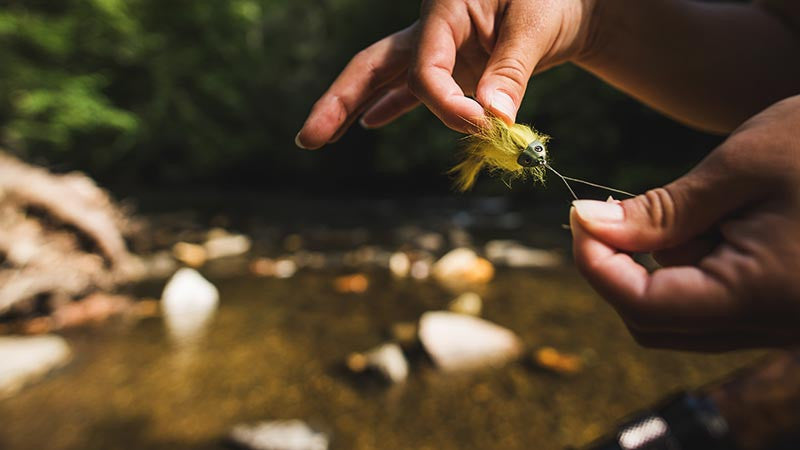
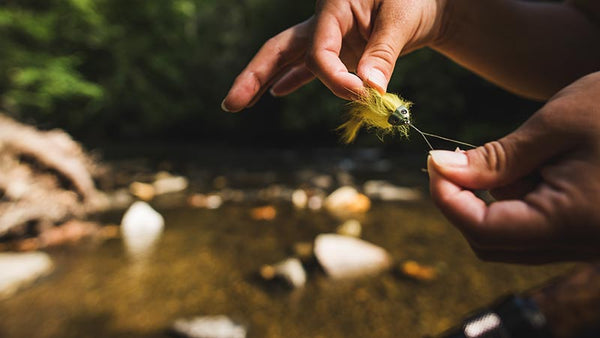
Over the Last 20 Years of Streamer Fishing I’ve Encountered Many Different Situations
I've fished fast Western rivers, Southern tailwaters with variations of speed based on dam flows, and slow Midwestern streams and lakes.
One of the most important factors I have found to maximize fly action is having the correct weight for each situation.
Flies swim differently depending on the amount of weight added and the materials used to counteract that weight.
I frequently tie a fly pattern in a variety of weights.
The general rule is the less the speed of current, the less weight is needed on your fly.
Slow, Still Water = Unweighted Flies
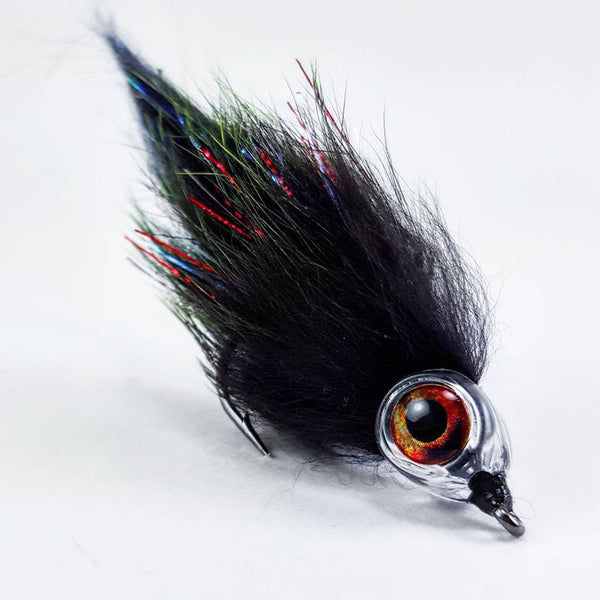
Unweighted streamer by FLY FIXX tied with a Fish-Skull Fish-Mask and Living Eyes.
Select a fly with no weight, or little weight, on lakes and in slow sections of river.
Make long casts and use the fly line, not the fly, to get depth.
Most of the pools on Western rivers fall into this category, and the majority of Midwestern rivers have sections of very slow water.
Typical patterns I use in still/slow water situations are Willen’s Mini Double Nickle, Super Zoo Cougars, CJ’s Sluggo, Great Lakes Fly Double Deceivers, and Modern Deceivers.
The style of fly Blane Chocklett ties by reverse tying, or using his signature Body Tubing, with deer hair or bucktail on shanks is phenomenal in this speed of water.
Swing It! Spey Streamer Fly Fishing Tips
Unweighted flies have more side-to-side action and hover on the pause. When weight is added, the fly falls on the pause, which can be a trigger, but so can a pause where the fly suspends. Trout tend to favor the fly with a fall in colder water situations, and it will typically outproduce unweighted flies in water temps under 45 degrees Fahrenheit.
Using a two hand strip, or “burning", the fly in slower water can have tremendous results. The typical problem I've had with fish in slow water is they follow but don’t eat frequently. By speeding up the retrieve, the fish have a tendency to attack instead of follow.
A general rule I use concerning speed of retrieve is a slow retrieve in fast water and a fast retrieve in slow water.
Fast, Shallow Water = Medium Weight Flies

Lovechild Sculpins. The larger fly on the left (tied with a small Fish-Skull Sculpin Helmet) will get much quicker depth penetration but in slower currents will lose much of its action. The smaller fly on the right (tied with a mini Fish-Skull Sculpin Helmet) will have more side-to-side action in its fall. In fast currents most of the side-to-side action will be muted.
In faster water that isn’t deep, some weight is needed to get the fly down, but too much and it’ll be on the bottom.
Some examples of these type flies are Sex Dungeon, Conrad’s Sculpin and Schmidt’s Viking Midge.
I tend to tie with mini and small Sculpin Helmets, small and extra-small lead eyes, and smaller Baitfish Heads.
When these lighter weights are used and the weight is in balance they'll cast with ease and also have some side to side movement on the fly during the fall.
The speed of fall is controlled by using materials that drag or are buoyant. By adding a deer hair head or wrapping a brush directly behind the weight you can maximize the action.
Small Stream Fly Fishing Tactics
Another advantage to the lighter weight is that casting is much easier with a little less weight than a true “heavy” fly. Success in streamer fishing has a lot to do how many casts you can put out per day.
With a little less weight it is much easier on your arm and shoulder so you will last longer. It's also much safer.
I guide around 180 days a year and not everyone I take fishing is an expert, which is why I started to tie with less weight. Most anglers can cast a well-balanced fly but the moment the weight overrides the fly’s material it becomes a very difficult cast, which is more of a lob than a cast. Rods will break and I’ve seen a baseball cap stapled to an angler’s head with a heavy fly.
Fast, Deep Water = Weighted and Traditional Jig-type Flies
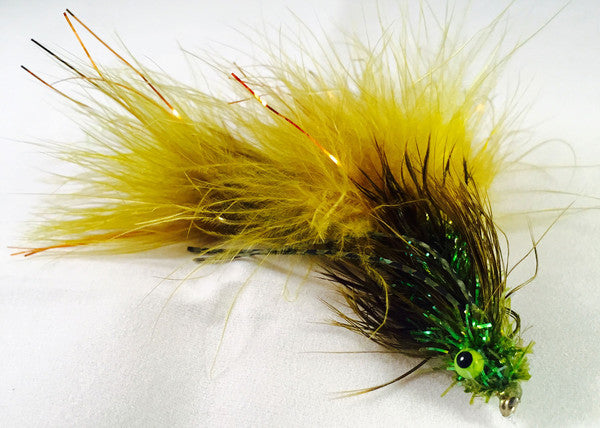
Tips Up jig-style fly created and tied by Kelly Galloup. Photo by Gunnar Brammer.
Most of the time, in fast water, fish are pinned to the banks.
Maddin’s Circus Peanut, CJ’s Sculpin, and a list of Galloup’s patterns (Nancy P’s, Barely Legals, etc.).
In these situations your fly needs achieve depth next to the bank.
I tend to use small and large Sculpin Helmets, medium and large lead eyes, larger Baitfish Heads, and large cones.
Other than just the amount of weight, you should consider the materials you're using.
They're at Your Feet, Dude! 6 Reasons To Make Shorter Casts When Wade Fishing
When tying for maximum depth, use materials that'll give you profile without bulk. I like my flies to carry a large profile, but want them to also be able to fall quickly in the water column.
Many of the flies I tie are with bucktail and schlappen feathers. These materials, when used sparsely, will create a large profile.
Rabbit and marabou will give you good action in the water but they soak up so much water they become harder to cast.
Bucktail and feathers will stay light in the water and out, and cast like a bullet.
Many of the new body wrap materials do not hold moisture and will help meet your needs. I use many colors of UV Polar Chenille and Senyo’s Aqua Veil Chenille.
Putting It All Together
Every streamer box should cover all of these categories. No one fly or one weight will cover all situations.
When I fish, I usually have multiple rods rigged for the different situations.
Usually I have a Sage Method with an InTouch OutBound 37’ sink tip and an unweighted fly and a Sage SALT with an InTouch Striper sink tip on the other with a weighted fly which is selected depending on the river or flows for the day.
I run this system because the Method is the best distance casting rod I have fished and I use long casts with unweighted flies to cover slower sections of river.
In close, the Method isn’t as accurate as the SALT so I switch over to the shorter sink tip and weighted fly to pick the structure in the faster water.
I know anglers will benefit from switching flies from section to section; I see it all the time in the winter on White River in Arkansas. Flows vary from 1,500 to 18,000 cfs and every day is different.
If you go out with one fly every day you will succeed some days and fail on others.
By switching your approach when conditions change you will catch more fish than ever because you will be effectively fishing all the water you float or wade through.
Want More Articles Like This?
Join the Flymen Mailing List at the Bottom of the Page!
About Alex Lafkas:
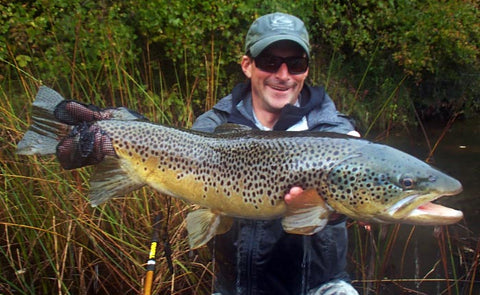
Alex Lafkas has been a fly fishing guide in Northern Michigan since 2000 and has been fly fishing the Au Sable and Manistee Rivers for over 20 years. Alex began commercial tying in 1994 for Gates AuSable Lodge in Grayling, MI. He has learned from the best anglers and guides on these rivers. He is extremely passionate about fly fishing, guiding, and fly tying. Alex’s college years took him to Montana where he spent days and nights fishing the Yellowstone, Beaverhead, Madison, and many other great rivers. There is no off season for Alex; he takes advantage of the extended seasons on both the Au Sable and Manistee Rivers. Years ago he began heading to Arkansas and fishing and guiding on the White and Norfork Rivers in the winter months. He introduced the guides and fishermen on the White River to the big streamer game, a technique which is now considered one of the most effective to target large browns on the Southern Tailwaters. As an instructor, Alex is very patient and willing to share his vast knowledge of trout, and the rivers they live in with clients. Alex is a member of the Sage Elite Staff, is an Ambassador Guide for Simms Fishing Products and a member of the Flycraft USA and Flymen Fishing Co. Pro Staffs. You can follow Alex @alflyfishing on Instagram as well.


I’m trying to get started, I still need lots of pratice.
I also say thank you (as Capt. Moron pointed out) for mentioning the the fact that streamers falling ,in colder water, on the swing elicit strikes.
Many thanks
DB
thank you for including tempreture conditions in your ariticle,a very over looked component in resivoir fly fishing. Looking forward to more good reads. All the best cbm
None now
thanks for the education I will tie some streamers and give them a very good try this year thanks again
Leave a comment